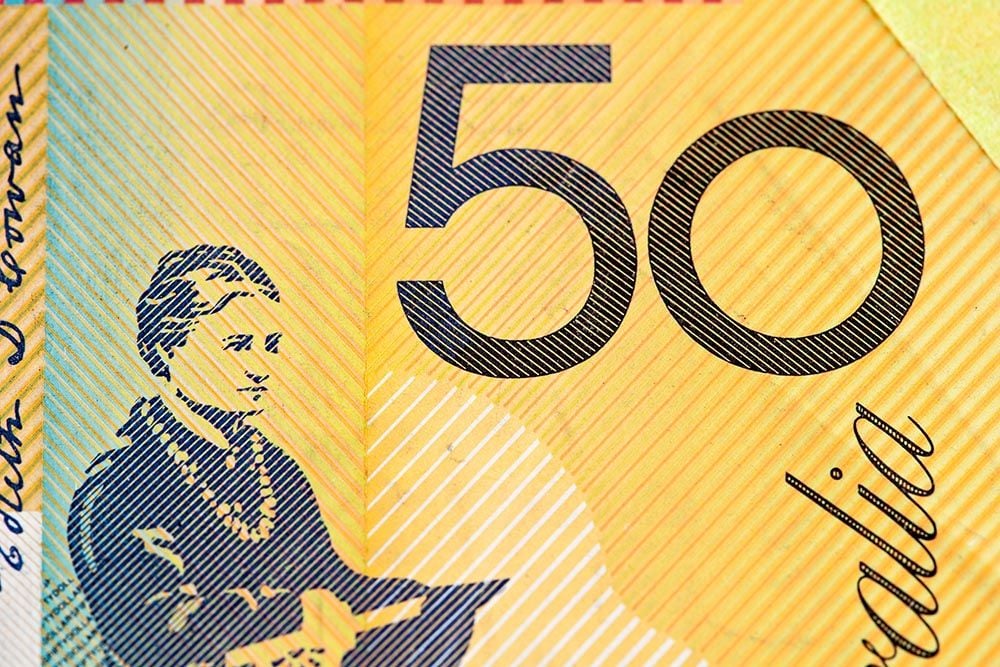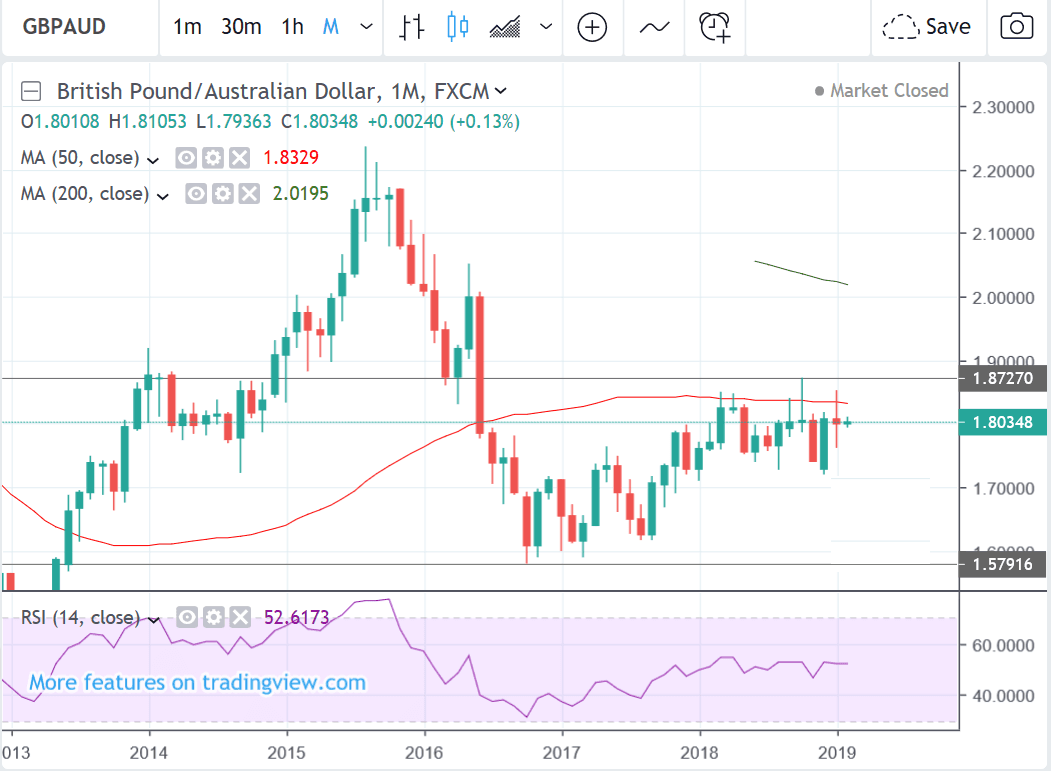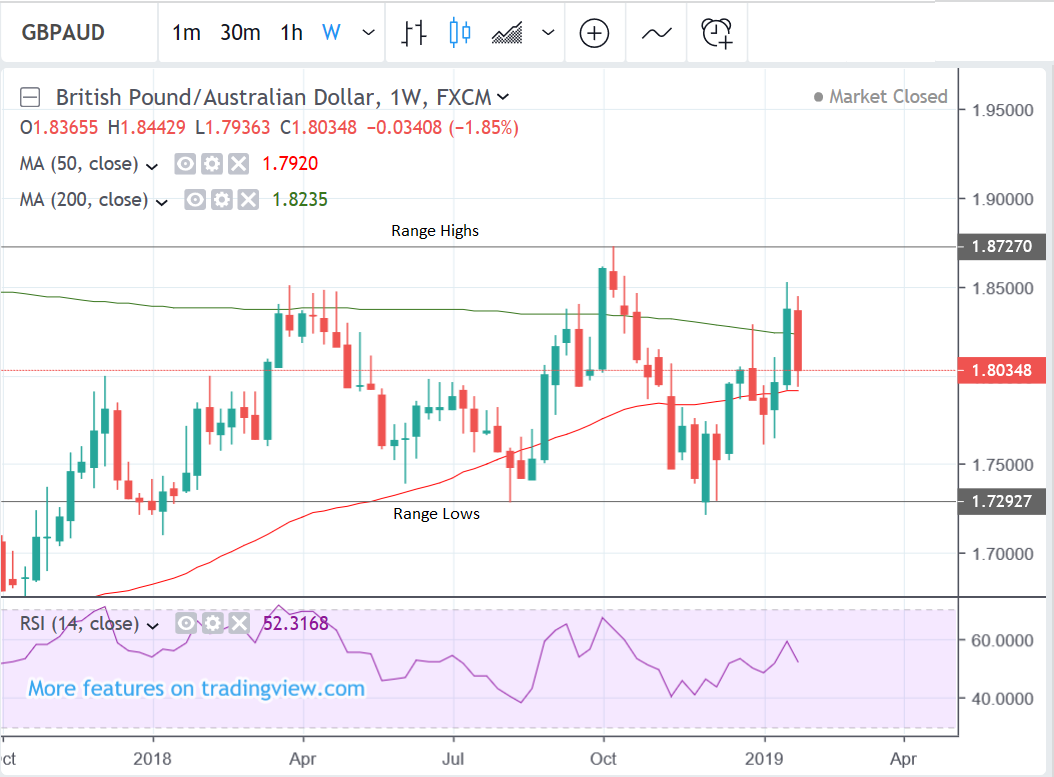Pound-to-Australian Dollar Week Ahead Forecast: Short-term Bearish, Medium-Term Bullish

© Greg Brave, Adobe Stock
- GBP/AUD lost 1.85% last week after Brexit risks rose
- Short-term trend down but longer-term signals bullish
- BOE and RBA rate decisions dominate the calendar
The Pound-to-Australian Dollar rate is trading at 1.8035 at the start of the new week after falling 1.85% in the week before, as Brexit deadlock strangled Sterling's 2019 rally higher and global investor sentiment improved further, providing a boost for the Australian currency.
From a technical perspective, the immediate outlook for GBP/AUD is probably marginally bearish after the big sell-off last week.
However, in the medium-term we are bullish, on the condition that the pair can successfully break above the 50-month moving average (MA) which has been acting as a glass ceiling capping gains for many months.
The 50-month moving average (MA) is situated at 1.8329 and is expected to continue to contain upside as it has done on multiple occasions in the past.
Yet at the same time, it is also the case that multiple attempts at breaking through a level can eventually succeed and lead to an even more volatile surge when successful.
The weekly chart looks quite neutral as the pair trades within a range between 1.79 and 1.87.
On this chart GBP/AUD also recently fell back below the 200-week MA after temporarily breaking above it which suggests a confused outlook. In a stronger trending market, the break would have been a spur to more gains.
The daily chart shows that the pair did pull-back after forming an ABCD pattern with legs AB and CD of about equal length.
GBP/AUD now also appears to be pulling back into a support zone in the region of the 1.78s where the 50 and 200-day MAs and the trendline for the move up from the December low is situated. This is expected to provide a cushion of support and prevent further declines, at least temporarily. It could also lead to a rebound higher if the uptrend was to resume.
There is a possibility in the short-term of a small penetration into the ‘support zone’, perhaps, down to the trendline at 1.7860.
But more broadly we see a likely turnaround thereafter as traders will be looking for bullish signals within the ‘support zone’ so they can trade the up-cycle to the 1.85 highs.
The bar for an extension higher, in the medium-term, however, is quite high because of the ambiguity on the weekly chart and the obstruction from the 50-month MA.
An extension would be conditional upon a clear break above the MA, requiring a move above the October highs at 1.8725 for confirmation. Such a move might well reach 1.9000 however.
It is unlikely the October highs will be knocked out in the week ahead but it is possible they may be in the next month.
Time to move your money? Get 3-5% more currency than your bank would offer by using the services of foreign exchange specialists at RationalFX. A specialist broker can deliver you an exchange rate closer to the real market rate, thereby saving you substantial quantities of currency. Find out more here.
* Advertisement
The Australian Dollar: What to Watch this Week
The main domestic event for the Australian Dollar is the Reserve Bank of Australia (RBA) interest rate decision on Tuesday at 3.30 GMT, and the publication of the RBA’s official statement on monetary policy on Friday at 12.30.
There appears to be no clear cut consensus on what the RBA is likely to do with monetary policy - or rather a wide range of differing views. Previous expectations had been for the RBA to, on balance, probably cut interest rates eventually on falling inflation and growth projections, however, slightly higher-than-expected inflation data in Q4 reduced the possibility of an RBA rate cut.
“The RBA has so far mostly stuck to its rosy growth outlook for 2019 but the markets don’t agree and are pricing in a small chance of a rate cut by year-end. Investors think the soft inflation picture in Australia and the deepening slowdown in China will force the RBA to either delay a hike in the cash rate or to cut it,” says Raffi Boyadjian, currency analyst at broker XM.com.
While the RBA dominates the domestic agenda, we believe the global outlook would likely be of greater significance for the Australian Dollar which is showing a strong correlation with investor sentiment, going up when markets rise, and down when markets turn red.
The outlook for trade talks between China and the U.S. will be key for investors.
The chances of the U.S. and China reaching a successful trade deal have increased of late and this should support the outlook for the Australian economy and encourage an outlook which supports higher interest rates.
“We are getting more confident that we are closer to a deal and that the probability of a deal in March has increased,” says Allan von Mehren, chief analysts at Danske Bank. “The intense efforts put into the talks at the highest level – including from Trump and Xi – suggest that both sides are very keen to get the work done.”
Von Mehren’s rationale for believing a deal is close to being agreed is that China needs “more breathing space in tackling its debt challenges” and “Trump can present himself as the great deal maker to the American population going into the 2020 election campaign with a package that will benefit key voters in swing states.”
China targeted its own tariffs carefully to hit Trump’s heartland and the tactic appears to have worked because apparently at a recent meeting in the oval office, “Trump emphasised several times the large amount of soybeans that China will now buy and how it would benefit the farmers,” says Von Mehren.
Building permits is another key release for the Australian Dollar. It is out at 12.30 on Tuesday and is forecast to show a 1.8% rise after a -9.1% decline in November. Housing is often seen as an early warning for the broader economy.
The AIG Services index is another key release for the Aussie in the week ahead, which is out on Monday at 22.30. It is a sentiment survey which provides a leading indicator for the sector. In the previous month, it gave a reading of 52.1, which was above the 50.0 level which distinguishes growth from contraction.
The Pound: What to Watch this Week
Brexit will be the primary focus for Sterling markets in the week ahead with focus likely to be trained on whether Prime Minister May can squeeze any compromises out of the EU in regards to the Irish backstop.
Writing in the Sunday Telegraph this weekend, May said she would return to Brussels with a "fresh mandate, new ideas and a renewed determination".
MPs have voted to seek an "alternative arrangement" to guarantee the Northern Ireland border stays open after Brexit.
Once again, this weekend saw the Irish deputy prime minister say "there are no credible alternative arrangements" to the proposal.
There is a seemingly intractable deadlock in place between the UK and EU on the matter, and we wonder if this week will give us any new information on the matter.
Unless no new information that sheds clarity on the deadlock is offered we would expect the Pound to consolidate.
The main calendar event in the week ahead for the Pound is the meeting of the Bank of England (BOE) on Thursday at 12.00 GMT.
This meeting is more important than most because it will also include the BOE’s official quarterly economic forecasts, and a press conference with the BOE chairman Mark Carney afterward.
Whilst no interest rate changes are expected, the forecasts will speak volumes about the Bank’s assessment of the state of the economy, and could impact the Pound. Carney’s comments will also be closely parsed for a steer on future stance.
Data has been mixed recently and if the BOE’s assessment is negative it could weigh on Sterling - likewise a more resilient outlook would strengthen the Pound as it would make a case for multiple interest rate hikes in the event of Brexit uncertainty being removed.
Given a backdrop of heightened global growth fears and increased Brexit uncertainty the consensus seems to be tilted towards expecting a more sombre and cautious message from the Bank which would weigh marginally on Sterling.
“Policymakers had already taken a more cautious stance at the last meeting in December as the Brexit uncertainty dragged on and given the heightened anxiety about the global growth outlook since then, the Bank could go one step further and signal fewer rate hikes than currently being projected for the next three years,” says Raffi Boyadjian, currency analysts at FX broker XM.com.
The other main data release for the Pound is Construction and Services PMI for January.
The week starts with the release of Construction PMI on Monday at 9.30 GMT, with estimates for a decline to 52.4 from 52.8 previously.
Services is out on Tuesday at 9.30 and is expected to drop to 51.0 from 51.1 in the previous month.
A greater than expected decline in PMIs may well be an early warning sign of a decline in the broader economy since PMIs are seen as leading indicators, and this could weigh on the Pound. Likewise, a surprise rise, suggesting underlying resilience, could strengthen Sterling.
Time to move your money? Get 3-5% more currency than your bank would offer by using the services of foreign exchange specialists at RationalFX. A specialist broker can deliver you an exchange rate closer to the real market rate, thereby saving you substantial quantities of currency. Find out more here.
* Advertisement








